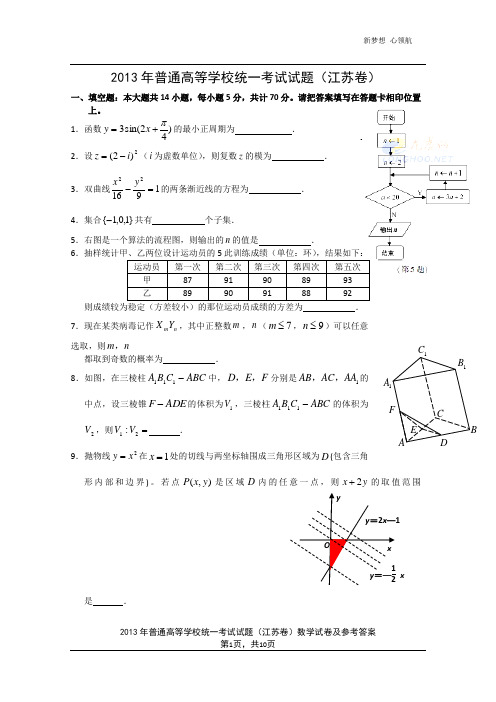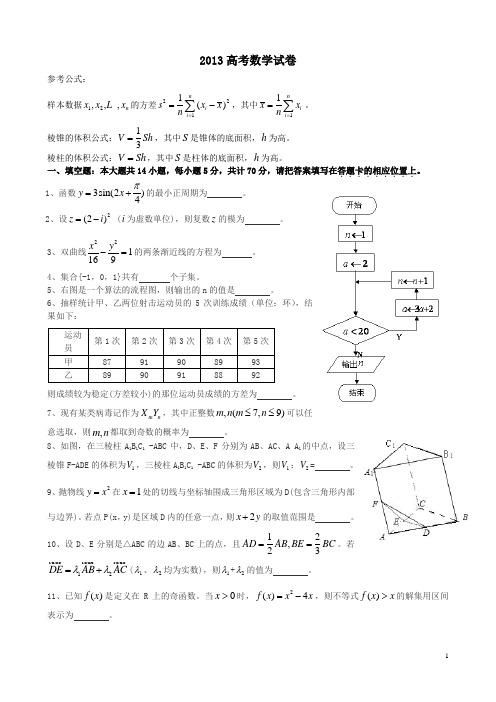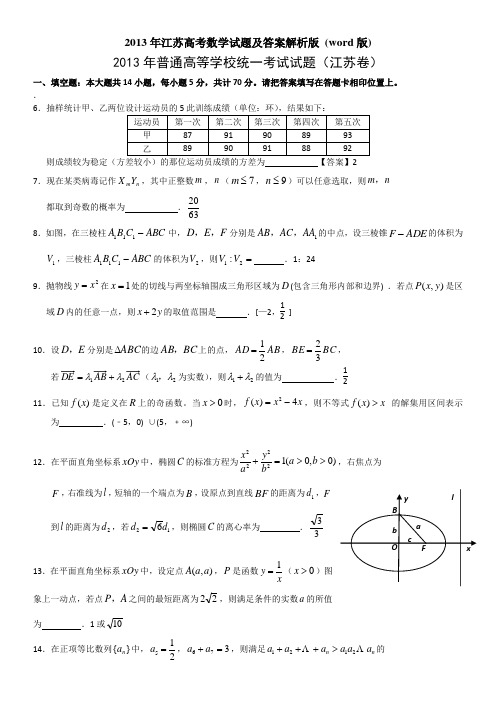2013江苏高考真题及答案
da2013年高考数学试卷答案 江苏

2013年普通高等学校统一考试试题(江苏卷)答案一、填空题1、π2、53、34y x =±4、85、46、27、2063 8、1249、1[2,]2-10、1211、(5,0)(5,)-⋃+∞12 13、1,3- 14、12二、解答题15、(1)略 (2)5,66ππαβ==16、证:(1)SA BA =,AF SB ⊥,SF BF ∴=,由题SE EA =,//EF AB ∴,EF ⊄平面ABCAB ⊂平面ABC ,//EF ∴平面ABC ,同理//EG 平面ABC ,EF 与EG 为平面EFG 内的两条相交直线,∴平面//EFG 平面ABC ,(2)平面⊥SAB 平面SBC 于SB ,AF ⊂平面SAB ,AF ∴⊥平面SBC ,AF BC ∴⊥, 又BC AB ⊥且AB 与AF 为平面SAB 内的两条相交直线,BC SA ∴⊥。
17、解:(1)由题设点(,24)C a a -,又C 也在直线1-=x y 上,241,3a a a ∴-=-∴= 22:(3)(2)1C x y ∴-+-=,由题,过A 点切线方程可设为3y kx =+,即30kx y -+=,1=,解得:30,4k =-,∴所求切线为3y =或334y x =-+(2)设点(,24)C a a -,00(,)M x y ,2MA MO =,)3,0(A ,(0,0)O ,22220000(3)4()x y x y ∴+-=+,即2200032x y y +=-,又点M 在圆C 上,2200()(24)1x a y a ∴-+-+=,两式相减得2005(23)(89)02a ax a y a +---+=,由题以上两式有公共点,21≤整理得:25|63|2a a -+≤,即222(5126)4(5129)a a a a -+≤-+,令25126t a a =-+,则24(3)t t ≤+,解得:26t -≤≤,2251266a a ∴-≤-+≤,解得:1205a ≤≤. 18、解:(1)在ABC ∆中,1312cos =A ,53cos =C ,5sin 13A ∴=,4sin 5C =, 63sin sin()sin cos cos sin 65B A C A C A C ∴=+=+=,sin sin AB ACC B=,5651260463AB ⨯∴=, 1040AB ∴=.答:索道AB 的长为1040m .(2)设乙出发min t 到点P ,则甲出发(2)min t +到点Q ,130AP t =,50(2)AQ t =+,在APQ ∆中,222222122cos (130)50(2)213050(2)13PQ AP AQ APAQ A t t t t =+-=++-⨯⨯+⨯, 2222222100[(13)5(2)120(2)]100[16925(2)120(2)]PQ t t t t t t t t ∴=++-+=++-+ 22100(74140100)PQ t t ∴=-+,当且仅当35min 37t =时,PQ 最小. 答:乙出发3537分钟后,乙在缆车上与甲的距离最短. (3)甲走完长为m 1260的山路AC ,共需126025.250=分钟,设乙总用时为min t ,乙步行的速度为/min vm ,则22.228.2t ≤≤,由题104021130BCt v=+++,在ABC ∆中,由正弦定理求得500BC =,50011[22.2,28.2]t v ∴=+∈,500[11.2,17.2]v ∴∈,11[,]50017.211.2v ∴∈,500500[,]17.211.2v ∴∈,500500[,]17.211.2v ∴∈,50005000[,]172112v ∴∈,50005000[,]172112v ∴∈,39[29,44]4314v ∴∈答:为使两位游客在C 处互相等待的时间不超过3分钟,乙步行的速度应控制329/min43m 到944/min 14m 内.19、证明:(1)若0=c ,则n n S b n =,*N n ∈,又由题(1)2n n n dS na -=+,12n n S n b a d n -∴==+,112n n b b d +∴-=,{}n b ∴是等差数列,首项为a ,公差为2d,)0(≠d ,又421b b b ,,成等比数列, 2214b b b ∴=,23()()22d da a a ∴+=+,23()42d d ad a ∴+=,0d ≠,2d a ∴=,2n S n a ∴=,222222(),nk k S nk a n k a n S n k a ∴===,2nk k S n S ∴=(*,N n k ∈). (2)由题c n nS b n n +=2,*N n ∈,22[2(1)]2()n n a n d b n c +-=+,若}{n b 是等差数列,则可设n b x yn =+,,x y 是常数,22[2(1)]2()n a n d x yn n c +-=++关于*N n ∈恒成立.整理得:32(2)(22)220d y n a d x n cyn cx -+----=关于*N n ∈恒成立.20,220,20,20d y a d x cy cx ∴-=--===,20,22,0,0d y a x d cy cx ∴=≠-===0c ∴=。
2013年江苏省高考数学试卷及答案

2013年普通高等学校统一考试试题(江苏卷)数学试卷及参考答案2013年普通高等学校统一考试试题(江苏卷)一、填空题:本大题共14小题,每小题5分,共计70分。
请把答案填写在答题卡相印位置上。
1.函数)42sin(3π+=x y 的最小正周期为 .2.设2)2(i z -=(i 为虚数单位),则复数z 的模为 .3.双曲线191622=-y x 的两条渐近线的方程为 . 4.集合}1,0,1{-共有 个子集.5.右图是一个算法的流程图,则输出的n 的值是 . 6.抽样统计甲、乙两位设计运动员的5此训练成绩(单位:环),结果如下:运动员 第一次第二次 第三次 第四次 第五次 甲 87 91 90 89 93 乙8990918892则成绩较为稳定(方差较小)的那位运动员成绩的方差为 . 7.现在某类病毒记作n m Y X ,其中正整数m ,n (7≤m ,9≤n )可以任意选取,则n m ,都取到奇数的概率为 .8.如图,在三棱柱ABC C B A -111中,F E D ,,分别是1AA AC AB ,,的中点,设三棱锥ADE F -的体积为1V ,三棱柱ABC C B A -111的体积为2V ,则=21:V V .9.抛物线2x y =在1=x 处的切线与两坐标轴围成三角形区域为D (包含三角形内部和边界)。
若点),(y x P 是区域D 内的任意一点,则y x 2+的取值范围是 .yx Oy =2x —1y =—12 xABC1ADE F1B1C2013年普通高等学校统一考试试题(江苏卷)数学试卷及参考答案y x lB FOcb a 10.设E D ,分别是ABC ∆的边BC AB ,上的点,AB AD 21=,BC BE 32=, 若AC AB DE 21λλ+=(21λλ,为实数),则21λλ+的值为 .11.已知)(x f 是定义在R 上的奇函数。
当0>x 时,x x x f 4)(2-=,则不等式x x f >)( 的解集用区间表示为 .12.在平面直角坐标系xOy 中,椭圆C 的标准方程为)0,0(12222>>=+b a by a x ,右焦点为F ,右准线为l ,短轴的一个端点为B ,设原点到直线BF 的距离为1d ,F 到l 的距离为2d ,若126d d =,则椭圆C 的离心率为 .13.在平面直角坐标系xOy 中,设定点),(a a A ,P 是函数xy 1=(0>x )图象上一动点, 若点A P ,之间的最短距离为22,则满足条件的实数a 的所有值为 . 14.在正项等比数列}{n a 中,215=a ,376=+a a ,则满足n n a a a a a a 2121>+++的 最大正整数n 的值为 .二、解答题:本大题共6小题,共计90分.请在答题卡指定区域内作答,解答时应写出文字说明、证明过程或演算步骤. 15.(本小题满分14分) 已知)sin ,(cos )sin ,(cos ββαα=b a ,=,παβ<<<0.(1)若2||=-b a ,求证:b a ⊥;xyy =xy =x 2—4 xP (5,5)Q (﹣5, ﹣5)2013年普通高等学校统一考试试题(江苏卷)数学试卷及参考答案(2)设)1,0(=c ,若c b a =+,求βα,的值.16.(本小题满分14分)如图,在三棱锥ABC S -中,平面⊥SAB 平面SBC ,BC AB ⊥,AB AS =,过A 作SB AF ⊥,垂足为F ,点G E ,分别是棱SC SA ,的中点.求证: (1)平面//EFG 平面ABC ;(2)SA BC ⊥.17.(本小题满分14分)如图,在平面直角坐标系xOy 中,点)3,0(A ,直线42:-=x y l . 设圆C 的半径为1,圆心在l 上.(1)若圆心C 也在直线1-=x y 上,过点A 作圆C 的切线, 求切线的方程;(2)若圆C 上存在点M ,使MO MA 2=,求圆心C 的横坐 标a 的取值范围.A B CSG F E xy A lO2013年普通高等学校统一考试试题(江苏卷)数学试卷及参考答案18.(本小题满分16分)如图,游客从某旅游景区的景点A 处下山至C 处有两种路径。
2013年江苏高考数学试题及答案(含理科附加题)WORD版

8、如图,在三棱柱A1B1C1-ABC中,D、E、F分别为AB、AC、A A1的中点,设三棱锥F-ADE的体积为 ,三棱柱A1B1C1-ABC的体积为 ,则 : =▲。
答案:1:24
9、抛物线 在 处的切线与坐标轴围成三角形区域为D(包含三角形内部与边界)。若点P(x,y)是区域D内的任意一点,则 的取值范围是▲。
[解析]本小题主要考查等差数列、等比数列的定义、通项、求和等基础知识,考查分析转化能力及推理论证能力。满分16分。
20、(本小题满分16分)设函数 ,其中 为实数。(1)若 在 上是单调减函数,且 在 上有最小值,求 的取值范围;(2)若 在 上是单调增函数,试求 的零点个数,并证明你的结论。
[解析]本小题主要考查导数的运算及利用导数研究函数的性质,考查函数、方程及不等式的相互转化,考查综合运用数学思想方法分析与解决问题能力及推理论证能力。满分16分。
(2)若圆C上存在点M,使MA=2MO,求圆心C的横坐标 的取值范围。
[解析]本小题主要考查直线与圆的方程,直线与直线、直线与圆、圆与圆的位置关系等基础知识,考查运用数形结合、待定系数法等数学思想方法解决问题的能力。满分14分。
18、(本小题满分16分)
如图,游客从某旅游景区的景点A处下山至C处有两种路径。一种是从A沿直线步行到C,另一种是先从A沿索道乘缆车到B,然后从B沿直线步行到C。
答案:
13、在平面直角坐标系xoy中,设定点A(a,a),P是函数 图象上的一动点。若点P、A之间的最短距离为 ,则满足条件的实数a的所有值为=▲。
答案:
14、在正项等比数列 中, ,则满足 的最大正整数n的值为▲。
答案:12
二、解答题:本大题共6小题,共计90分,请在答题卡指定区域内作答,解答时应写出文字说明、证明或演算步骤.
2013江苏省高考数学真题含答案清晰版

2013高考数学试卷参考公式: 样本数据12,,,n x x x 的方差2211()n i i s x x n ==-∑,其中11n i i x x n ==∑。
棱锥的体积公式:13V Sh =,其中S 是锥体的底面积,h 为高。
棱柱的体积公式:V Sh =,其中S 是柱体的底面积,h 为高。
一、填空题:本大题共14小题,每小题5分,共计70分,请把答案填写在答题卡的相应位置上。
DE AB AC λλ=+(λ、11、已知()f x 是定义在R12n n a a a a ++>的最大正整数内作答,解答时应写出文字说明、证明或演.(本小题满分14分)已知向量(cos ,sin ),(cos ,sin ),0a b ααββ==(1)若||2a b -=,求证:a b ⊥;(2)设(0,1)c =,若a b c +=,求βα,的值。
16、(本小题满分14分)如图,在三棱锥S-ABC 中,平面⊥SAB 平面SBC,BC AB ⊥,AS=AB 。
过A 作SB AF ⊥,垂足为F ,点E 、G 分别为线段SA 、SC 的中点。
求证:(1)平面EFG//平面ABC ;(2)BC SA ⊥。
如图,在平面直角坐标系xoy 中,点A(0,3),直线42:-=x y l ,设圆C 的半径为1,圆心在直线l 上。
(1)若圆心C 也在直线1-=x y 上,过点A 作圆C 的切线,求切线的方程;(2)若圆C 上存在点M ,使MA=2MO ,求圆心C 的横坐标a 的取值范围。
18、(本小题满分16分)如图,游客从某旅游景区的景点A 处下山至C 处有两种路径。
一种是从A 沿直线步行到C ,另一种是先从A 沿索道乘缆车到B ,然后从B 沿直线步行到C 。
现有甲、乙两位游客从A 处下山,甲沿AC 匀速步行,速度为50米/分钟。
在甲出发2分钟后,乙从A 乘坐缆车到B ,在B 处停留1分钟后,再从B 匀速步行到C 。
假设缆车速度为130米/分钟,山路AC 的长为1260米,经测量,123cos ,cos 135A C ==。
2013年江苏高考数学试题及答案解析版1_(word版)

2013年普通高等学校统一考试试题(江苏卷)一、填空题:本大题共14小题,每小题5分,共计70分。
请把答案填写在答题卡相印位置上。
.6则成绩较为稳定(方差较小)的那位运动员成绩的方差为 【答案】2 7.现在某类病毒记作n m Y X ,其中正整数m ,n (7≤m ,9≤n )可以任意选取,则n m , 都取到奇数的概率为 .63208.如图,在三棱柱ABC C B A -111中,F E D ,,分别是1AA AC AB ,,的中点,设三棱锥ADE F -的体积为1V ,三棱柱ABC C B A -111的体积为2V ,则=21:V V .1:249.抛物线2x y =在1=x 处的切线与两坐标轴围成三角形区域为D (包含三角形内部和边界) .若点),(y x P 是区域D 内的任意一点,则y x 2+的取值范围是 .[—2,12 ]10.设E D ,分别是ABC ∆的边BC AB ,上的点,AB AD 21=,BC BE 32=, 若AC AB DE 21λλ+=(21λλ,为实数),则21λλ+的值为 .1211.已知)(x f 是定义在R 上的奇函数。
当0>x 时,x x x f 4)(2-=,则不等式x x f >)( 的解集用区间表示为 .(﹣5,0) ∪(5,﹢∞)12.在平面直角坐标系xOy 中,椭圆C 的标准方程为)0,0(12222>>=+b a by a x ,右焦点为F ,右准线为l ,短轴的一个端点为B ,设原点到直线BF 的距离为1d ,F 到l 的距离为2d ,若126d d =,则椭圆C 的离心率为 .3313.在平面直角坐标系xOy 中,设定点),(a a A ,P 是函数xy 1=(0>x )图象上一动点,若点A P ,之间的最短距离为22,则满足条件的实数a 的所值为 .1或1014.在正项等比数列}{n a 中,215=a ,376=+a a ,则满足n n a a a a a a 2121>+++的最大正整数n 的值为 .12二、解答题:本大题共6小题,共计90分.请在答题卡指定区域内作答,解答时应写出文字说明、证明过程或演算步骤. 15.(本小题满分14分) 已知)sin ,(cos )sin ,(cos ββαα=b a ,=,παβ<<<0.(1)若2||=-b a ,求证:b a ⊥;(2)设)1,0(=c ,若c b a =+,求βα,的值. 解:(1)a -b =(cosα-cosβ,sin α-sin β),|a -b |2=(cosα-cosβ)2+(sin α-sin β)2=2-2(cosα·cosβ+sin α·sin β)=2, 所以,cosα·cosβ+sin α·sin β=0,所以,b a ⊥. (2)⎩⎨⎧=+=+②1sin sin ①0cos cos βαβα,①2+②2得:cos(α-β)=-12 .所以,α-β=π32,α=π32+β,带入②得:sin(π32+β)+sin β=23cosβ+12 sin β=sin(3π+β)=1, 所以,3π+β=2π. 所以,α=65π,β=6π.16.(本小题满分14分)如图,在三棱锥ABC S -中,平面⊥SAB 平面SBC ,BC AB ⊥,AB AS =,过A 作SB AF ⊥,垂足为F ,点G E ,分别是棱SC SA ,的中点.求证: (1)平面//EFG 平面ABC ;(2)SA BC ⊥. 证:(1)因为SA =AB 且AF ⊥SB , 所以F 为SB 的中点. 又E ,G 分别为SA ,SC 的中点, 所以,EF ∥AB ,EG ∥AC .又AB ∩AC =A ,AB ⊂面SBC ,AC ⊂面ABC , 所以,平面//EFG 平面ABC . (2)因为平面SAB ⊥平面SBC ,平面SAB ∩平面SBC =BC ,AF ⊂平面ASB ,AF ⊥SB .所以,AF ⊥平面SBC .又BC ⊂平面SBC , 所以,AF ⊥BC .又AB ⊥BC ,AF ∩AB =A , 所以,BC ⊥平面SAB .又SA ⊂平面SAB , 所以,SA BC ⊥.17.(本小题满分14分)如图,在平面直角坐标系xOy 中,点)3,0(A ,直线42:-=x y l .设圆C 的半径为1,圆心在l 上. (1)若圆心C 也在直线1-=x y 上,过点A 作圆C 的切线, 求切线的方程;A BSG F E(2)若圆C 上存在点M ,使MO MA 2=,求圆心C 的横坐 标a 的取值范围.解:(1)联立:⎩⎨⎧-=-=421x y x y ,得圆心为:C (3,2).设切线为:3+=kx y ,d =11|233|2==+-+r k k ,得:430-==k or k .故所求切线为:343+-==x y or y .(2)设点M (x ,y ),由MO MA 2=,知:22222)3(y x y x +=-+,化简得:4)1(22=++y x ,即:点M 的轨迹为以(0,1)为圆心,2为半径的圆,可记为圆D . 又因为点M 在圆C 上,故圆C 圆D 的关系为相交或相切. 故:1≤|CD |≤3,其中22)32(-+=a a CD .解之得:0≤a ≤125 .18.(本小题满分16分)如图,游客从某旅游景区的景点A 处下山至C 处有两种路径。
2013年江苏高考化学试题及答案【解析版】

2013年江苏高考化学试题答案及解析1.燃料电池能有效提高能源利用率,具有广泛的应用前景。
下列物质均可用作燃料电池的燃料,其中最环保的是A.甲醇B.天然气C.液化石油气D.氢气【答案】D【解析】本题属于考核化学与社会问题中的节能减排、保护环境、资源利用等相关问题。
燃料电池的能量转换率为80%,普通燃烧过程能量转换率为30%左右(《选修四》教材P9-11),甲醇、天然气、液化石油气都含有碳元素,燃烧容易生成污染物。
氢气作为燃料电池的燃料,其产物又是水,对环境无危害性,从能效比及环境保护的角度看,氢气的确是最理想的能源。
太阳能和氢能全面使用将是新能源领域人类努力的方向。
2.下列有关化学用语表示正确的是A.丙烯的结构简式:C3H6B.氢氧根离子的电子式:C.氯原子的结构示意图:D.中子数为146、质子数为92的铀(U)原子14692U【答案】B【解析】有关化学用语常涉及常见物质的组成和结构,尤其是一些常见物质电子式、结构式、结构简式及模型、原子或离子结构示意图以及原子的表示方法等,内容比较基础。
丙烯的结构简式为CH2=CHCH3,A错误;B正确;氯原子结构示意图中最外层的电子数目为7,不是8,所以C错误;中子数为146、质子数为92的铀(U)原子的质量数为238,是23892U,所以D错误。
3.常温下,下列各组离子在指定溶液中一定能大量共存的是A.使甲基橙变红色的溶液:Mg2+、K+、SO42-、NO3-B.使酚酞变红色的溶液:Na+、Cu2+、HCO3-、NO3-C.0.1 mol·L-1AgNO3溶液:H+、K+、SO42-、I-D.0.1 mol·L-1NaAlO2溶液: H+、Na+、Cl-、SO42-【答案】A【解析】本题以溶液中离子共存的方式考查学生对指示剂的颜色变化,碱性溶液中的碳酸氢根离子、碘离子与银离子、偏铝酸根与氢离子等共存问题的理解程度,考查学生综合运用所学化学知识解决相关化学问题的能力。
2013年江苏数学高考试卷含答案和解析

2013年江苏数学高考试卷参考公式: 样本数据12,,,n x x x 的方差2211()n i i s x x n ==-∑,其中11n i i x x n ==∑。
棱锥的体积公式:13V Sh =,其中S 是锥体的底面积,h 为高。
棱柱的体积公式:V Sh =,其中S 是柱体的底面积,h 为高。
一、填空题:本大题共14小题,每小题5分,共计70分,请把答案填写在答题卡的相应......位置上...。
1、函数3sin(2)4y x π=+的最小正周期为 ▲ 。
2、设2(2)z i =- (i 为虚数单位),则复数z 的模为 ▲ 。
3、双曲线221169x y -=的两条渐近线的方程为 ▲ 。
4、集合{-1,0,1}共有 ▲ 个子集。
5、右图是一个算法的流程图,则输出的n 的值是 ▲ 。
6、抽样统计甲、乙两位射击运动员的5次训练成绩(单位:环),结果如下:则成绩较为稳定(方差较小)的那位运动员成绩的方差为 ▲ 。
7、现有某类病毒记作为m n X Y ,其中正整数,(7,9)m n m n ≤≤可以任意选取,则,m n 都取到奇数的概率为 ▲ 。
8、如图,在三棱柱A 1B 1C 1 -ABC 中,D 、E 、F 分别为AB 、AC 、A A 1的中点,设三棱锥F-ADE 的体积为1V ,三棱柱A 1B 1C 1 -ABC 的体积为2V ,则1V :2V = ▲ 。
9、抛物线2y x =在1x =处的切线与坐标轴围成三角形区域为D(包含三角运动员 第1次 第2次 第3次 第4次 第5次 甲 87 91 90 89 93 乙8990918892形内部与边界)。
若点P(x ,y)是区域D 内的任意一点,则2x y +的取值范围是 ▲ 。
10、设D 、E 分别是△ABC 的边AB 、BC 上的点,且12,23AD AB BE BC ==。
若12DE AB AC λλ=+(1λ、2λ均为实数),则1λ+2λ的值为 ▲ 。
2013年江苏高考数学试题及答案(含理科附加题)WORD版

绝密★启用前2013年普通高等学校招生全国统一考试(江苏卷)数学Ⅰ注意事项:考生在答题前请认真阅读本注意事项及各题答题要求1.本试卷共4页,均为非选择题(第1题-第20题,共20题)。
本卷满分为160分。
考试时间为120分钟。
考试结束后,请将本试卷和答题卡一并交回。
2.答题前请务必将自己的姓名、准考证号用0.5毫米黑色墨水签字笔填写在试卷及答题卡的规定位置。
3.请认真核对监考员在答题卡上所粘贴的条形码上的姓名、准考证号与您本人是否相符。
4.作答试题,必须用0.5毫米黑色墨水签字笔在答题卡上的指定位置作答,在其他位置作答一律无效。
5.如需作图,须用2B 铅笔绘,写清楚,线条,符号等须加黑加粗。
参考公式: 样本数据12,,,n x x x 的方差2211()n i i s x x n ==-∑,其中11n i i x x n ==∑。
棱锥的体积公式:13V Sh =,其中S 是锥体的底面积,h 为高。
棱柱的体积公式:V Sh =,其中S 是柱体的底面积,h 为高。
一、填空题:本大题共14小题,每小题5分,共计70分,请把答案填写在答题卡的相应位置上.........。
1、函数3sin(2)4y x π=+的最小正周期为 ▲ 。
答案:π2、设2(2)z i =- (i 为虚数单位),则复数z 的模为 ▲ 。
答案:53、双曲线221169x y -=的两条渐近线的方程为 ▲ 。
答案:34y x =±4、集合{-1,0,1}共有 ▲ 个子集。
答案:85、右图是一个算法的流程图,则输出的n 的值是 ▲ 。
答案:36、抽样统计甲、乙两位射击运动员的5次训练成绩(单位:环),结果如下:则成绩较为稳定(方差较小)的那位运动员成绩的方差为 ▲ 。
答案:27、现有某类病毒记作为m n X Y ,其中正整数,(7,9)m n m n ≤≤可以任意选取,则,m n 都取到奇数的概率为 ▲ 。
答案:20638、如图,在三棱柱A 1B 1C 1 -ABC 中,D 、E 、F 分别为AB 、AC 、A A 1的中点,设三棱锥F-ADE 的体积为1V ,三棱柱A 1B 1C 1 -ABC 的体积为2V ,则1V :2V = ▲ 。
- 1、下载文档前请自行甄别文档内容的完整性,平台不提供额外的编辑、内容补充、找答案等附加服务。
- 2、"仅部分预览"的文档,不可在线预览部分如存在完整性等问题,可反馈申请退款(可完整预览的文档不适用该条件!)。
- 3、如文档侵犯您的权益,请联系客服反馈,我们会尽快为您处理(人工客服工作时间:9:00-18:30)。
2013年普通高等学校招生全国统一考试(江苏卷)英语试题第一部分: 听力(共两节,满分20分)做题时,先将答案标在试卷上。
录音内容结束后,你将有两分钟的时间将试卷上的答案转涂到答题卡上。
第一节(共5小题;每小题1分,满分5分)听下面5段对话。
每段对话后有一个小题,从题中所给的A、B、C三个选项中选出最佳选项,并标在试卷的相应位置。
听完每段对话后,你都有10秒钟的时间来回答有关小题和阅读下一小题。
每段对话仅读一遍。
例:How much is the shirt ?A. £19.15.B. £9.18.C. £9.15.答案是C。
1. What does the man want to do ?A. Take photos .B. Buy a camera .C. Help the woman.2. What are the speakers talking about ?A. A noisy night .B. Their life in town .C. A place of living.3. Where is the man now ?A. On his way.B. In a restaurant .C. At home.4. What will Celia do ?A. Find a player .B. Watch a game.C. Play basketball .5. What day is it when the conversation takes place?A. Saturday.B. Sunday.C. Monday.第二节(共15小题;每小题1分,满分15分)听下面5段对话或独白。
每段对话或独白后有几个小题,从题中所给的A、B、C 三个选项中选出最佳选项,并标在试卷的相应位置。
听每段对话或独白前,你将有时间阅读各个小题,每小题5秒钟;听完后,各小题将给出5秒钟的作答时间。
每段对话或独白读两遍。
听第6段材料,回答第6、7题。
6. What is Sara going to do ?A. Buy John a gift .B. Give John a surprise .C. Invite John to France .7. What does t he man think of Sara’s plan?A. Funny.B. Exciting.C. Strange.听第7段材料,回答第8、9题。
8. Why does Diana say sorry to Peter ?A. She has to give up her travel plan.B. She wants to visit another city.C. She needs to put off her test.9. What does Diana want Peter to do?A. Help her with her study.B. Take a book to her friend.C. Teach a geography lesson.听第8段材料,回答第10至12题。
10. Why does the man call the woman?A. To tell her about her new job.B. To ask about her job program.C. To plan a meeting with her.11. Who needs a new flat?A. Alex.B. Andrea.C. Miranda.12. Where is the woman now?A. In Baltimore.B. In New York.C. In Avon.听第9段材料,回答第13至16题。
13. What does Jan consider most important when he judges a restaurant ?A. Where the restaurant is .B. Whether the prices are low .C. How well the food is prepared .14.When did Jan begin to write for a magazine ?A. After he came back to Sweden .B. Before he went to the United States .C. As soon as he got find a good restaurant ?15. What may Jan do to find a good restaurant ?A. Talk to people in the street .B. Speak to taxi drivers.C. Ask hotel clerks .16.What do we know about Jan ?A. He cooks for a restaurant .B. He travels a lot for his work.C. He prefers American food .听第10段材料,回答第17至20题。
17. What do we know about the Plaza Leon?A. It’s a new building.B, It’s a small town . C. It’s a public place.18. When do Parents and children like going to the Plaza Leon ?A. Saturday nights.B. Sunday afternoons .C. Fridays and Saturdays.19. Why does the speaker like Horatio Street best ?A. Via del Mar Street .B. Fernmando Street .C. Hermandes Street .20. Why does the Speaker like Horatio Street best ?A. It has an old stone surface .B. It is named after a writer .C. It has famous university.第二部分:英语知识运用(共两节,满分35分)第一节:单项填空(共15小题;每小题1分,满分15分)请认真阅读下面各题,从题中所给的A、B、C、D四个选项中,选出最佳选项,并在答题卡上将该项涂黑。
例:It is generally considered unwise to give a child he or she wants.A. howeverB. whateverC. whicheverD. whenever答案是B。
21. Generally, students' inner motivation with high expectations from others essential to their development.A. isB. areC. wasD. were22. —The T-shirt I received is not the same as is shown online.—?But I promise you we’ll look into it ri ght away.A. Who saysB. How comeC. What forD. Why worry23. —The town is so beautiful! I just love it.—Me too. The character of the town is well .A. qualifiedB. preservedC. decoratedD. simplified24. Lionel Messi, the record for the most goals in a calendar year, is considered the most talented football player in Europe.A. setB. settingC. to setD. having set25. —Could I use your car tomorrow morning?—Sure. I a report at home.A. will be writingB. will have writtenC. have writtenD. have been writing26. I am always delighted when I receive an email fromyou. the party on July 1st ,I shall be pleased to attend .A. On account ofB. In response toC. In view ofD. With regard to27. “Never for a second ,”the boy says,“ that my father would come to my rescue.”A. I doubtedB. do I doubtC. I have doubtedD. did I doubt28. In the global economy, a new drug for cancer, it is discovered, will create many economic possibilities around the world.A. whateverB. whoeverC. whereverD. whichever29. Team leaders must ensure that all members their natural desire to avoid the embarrassment associated with making mistakes.A. get overB. look overC. takeoverD. come over30. I should not have laughed if I you were serious.A. thoughtB. would thinkC. had thoughtD. have thought31.Shortly after suffering from a massive earthquake and to ruins, the city took on a new look.A. reducingB. reducedC. being reducedD. having reduced32. The president of the World Bank says he has a passion for China , he remembers starting as early as his childhood.A. whereB. whichC. whatD. when33. With inspiration from other food cultures, American food culture can take a for the better.A. shareB. chanceC. turnD. lead34. —What about your self drive trip yesterday?—Tiring! The road is being widened, and we a rough ride.A. hadB. haveC. would haveD. have had35. —Thank you for the flowers.— . I thought they might cheer you up.A. That’s rightB. All rightC. I mall rightD. It’s all right第二节: 完形填空(共20 小题; 每小题1 分, 满分20 分)请认真阅读下面短文, 从短文后各题所给的A、B、C、D 四个选项中, 选出最佳选项, 并在答题卡上将该项涂黑。
